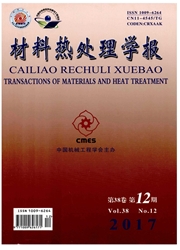

 中文摘要:
中文摘要:
对工业纯Cu和纯Fe冷拔变形,研究大变形下性能与组织的变化。研究表明,在大变形的情况下,与退火态相比其抗拉强度、硬度和电阻率均有提高。纯Cu的抗拉强度、显微硬度和电阻率在截面真应变4.621时分别提高80.5%、42.5%和8.00%;纯Fe的抗拉强度、显微硬度和电阻率在截面真应变3.544时分别提高198.2%、54.4%和3.16%。随真应变的增大,Cu、Fe抗拉强度均明显增加,Fe表现的尤为突出。Cu的硬度和电阻率在应变增加到一定值后基本保持不变,而Fe的硬度和电阻率与抗拉强度一样始终随应变的增加而增加。用纯Cu和纯Fe在截面真应变3.544时的抗拉强度计算了Cu-11.5%Fe原位复合材料在相应变形下的抗拉强度,计算结果与测量值相符。
 英文摘要:
英文摘要:
Cold-draw deformation for commercially pure Cu and pure Fe was carried out. Properties and microstructure of Cu and Fe under large deformation were studied. Compared with that of annealed Cu, tensile strength, microhardness and electrical resistivity of the deformed Cu at cross-section true strain 4.621 increase by 80.5%, 42.5% and 8.00%, respectively. Compared with that of annealed Fe, tensile strength, mierohardness and electrical resistivity, of the deformed Fe at cross-section true strain 3.544 increase by 198.2%, 54.4% and 3.160%, respectively. Tensile strength of Cu and Fe are obviously increase with true strain increasing, especially for Fe. Mierohardness and electrical resistivity of Cu increase rapidly with the increase of true strain under relatively smaller true strain, and then do not change under relatively larger true strain. However, mierohardness and electrical resistivity of Fe increase continuously with the increase of true strain. The tensile strength of Cu-l1.5%Fe in situ composites at true strain q = 3.544 was calculated based on the experimental result of tensile strength of pure Cu and Fe under corresponding deformation. The calculated value is consistent with the measured result.
 同期刊论文项目
同期刊论文项目
 同项目期刊论文
同项目期刊论文
 Effect of rare earth Nd on microstructure and mechanical properties of AZ31B wrought magnesium alloy
Effect of rare earth Nd on microstructure and mechanical properties of AZ31B wrought magnesium alloy Research on internal stress in electroplated Cu films on Fe substrates and Ni substrates –based on e
Research on internal stress in electroplated Cu films on Fe substrates and Ni substrates –based on e 期刊信息
期刊信息
